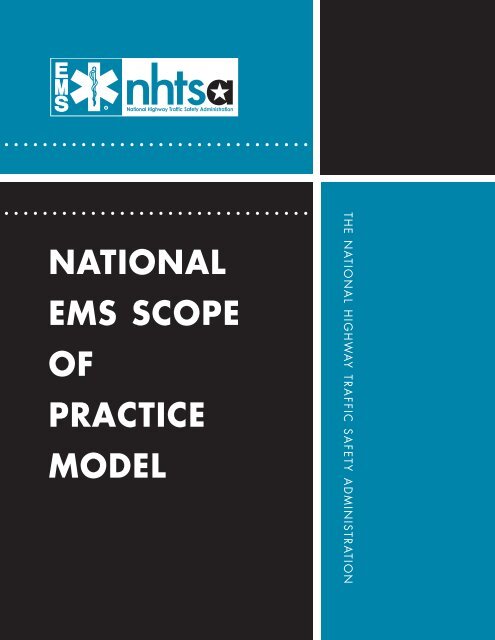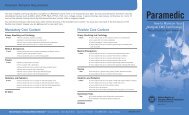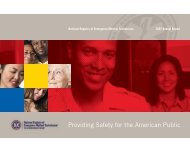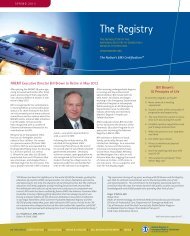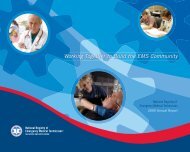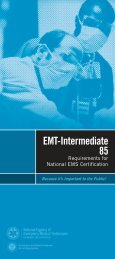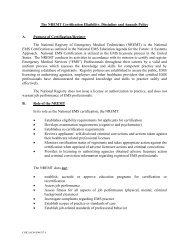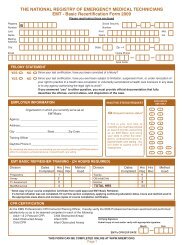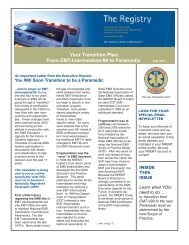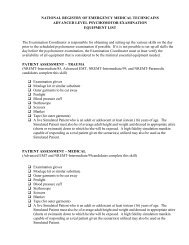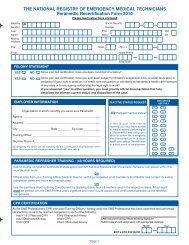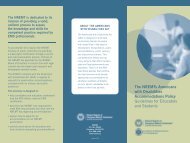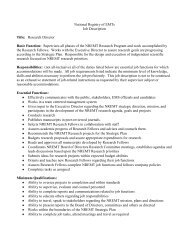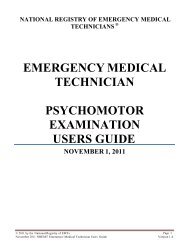NATIONAL EMS SCOPE OF PRACTICE MODEL - The National ...
NATIONAL EMS SCOPE OF PRACTICE MODEL - The National ...
NATIONAL EMS SCOPE OF PRACTICE MODEL - The National ...
Create successful ePaper yourself
Turn your PDF publications into a flip-book with our unique Google optimized e-Paper software.
<strong>NATIONAL</strong><br />
<strong>EMS</strong> <strong>SCOPE</strong><br />
<strong>OF</strong><br />
<strong>PRACTICE</strong><br />
<strong>MODEL</strong><br />
T H E N AT I O N A L H I G H WAY T R A F F I C S A F E T Y A D M I N I S T R AT I O N
<strong>The</strong> <strong>National</strong> <strong>EMS</strong> Scope of Practice Model<br />
Table of Contents<br />
<strong>The</strong> Vision of the <strong>EMS</strong> Agenda for the Future.................................................................3<br />
Executive Summary ........................................................................................................4<br />
Introduction ....................................................................................................................4<br />
History of Occupational Regulation in <strong>EMS</strong> ........................................................ 6<br />
<strong>The</strong> Development of the <strong>National</strong> <strong>EMS</strong> Scope of Practice Model ........................ 8<br />
<strong>The</strong> Role of State Government............................................................................. 8<br />
Scope of Practice ................................................................................................. 9<br />
<strong>The</strong> Interdependent Relationship Between Education, Certification,<br />
Licensure, and Credentialing ............................................................................. 10<br />
Scope of Practice versus Standard of Care ......................................................... 15<br />
A Comprehensive Approach to Safe and Effective Out-of-Hospital Care........... 15<br />
Scope of Practice for Special Populations .......................................................... 16<br />
Scope of Practice for <strong>EMS</strong> Personnel Functioning in Nontraditional Roles........ 16<br />
Scope of Practice during Disasters, Public Health Emergencies, and<br />
Extraordinary Circumstances............................................................................. 17<br />
Specializations................................................................................................... 17<br />
Implementation.................................................................................................. 17<br />
Overview of the <strong>EMS</strong> Profession .................................................................................. 18<br />
<strong>EMS</strong> Personnel Licensure Levels .................................................................................. 19<br />
Emergency Medical Responder ......................................................................... 20<br />
Emergency Medical Technician......................................................................... 20<br />
Advanced Emergency Medical Technician ........................................................ 21<br />
Paramedic.......................................................................................................... 21<br />
<strong>EMS</strong> Personnel Scope of Practice Models ..................................................................... 21<br />
Emergency Medical Responder ......................................................................... 22<br />
Description of the Profession............................................................................. 22<br />
Psychomotor Skills............................................................................................ 23<br />
Emergency Medical Technician......................................................................... 23<br />
Description of the Profession............................................................................. 23<br />
Psychomotor Skills............................................................................................ 24<br />
Advanced Emergency Medical Technician ........................................................ 25<br />
Description of the Profession............................................................................. 25<br />
Psychomotor Skills............................................................................................ 26<br />
Paramedic.......................................................................................................... 26<br />
Description of the Profession............................................................................. 26<br />
Psychomotor Skills............................................................................................ 27<br />
Knowledge.................................................................................................................... 28<br />
Appendix A: Interpretive Guidelines............................................................................ 29<br />
Airway and Breathing Minimum Psychomotor Skill Set .................................... 29<br />
Assessment Minimum Psychomotor Skill Set .................................................... 29<br />
Pharmacological Intervention Minimum Psychomotor Skill Set......................... 30<br />
Emergency Trauma Care Minimum Psychomotor Skill Set................................ 30<br />
1
Medical/Cardiac Care Minimum Psychomotor Skill Set .................................... 31<br />
Definitions .................................................................................................................... 32<br />
References .................................................................................................................... 35<br />
Acknowledgements....................................................................................................... 36<br />
Administrative Team ......................................................................................... 36<br />
Technical Advisory Group................................................................................. 36<br />
Task Force......................................................................................................... 36<br />
<strong>National</strong> Review Team ...................................................................................... 37<br />
Community Testimony ...................................................................................... 37<br />
Special Thanks To: ............................................................................................ 37<br />
2
<strong>The</strong> Vision of the <strong>EMS</strong> Agenda for the Future<br />
<strong>The</strong> <strong>National</strong> <strong>EMS</strong> Scope of Practice Model is part the <strong>National</strong> Highway Traffic Safety<br />
Administration’s commitment to the <strong>EMS</strong> Agenda for the Future. Released in 1996, the<br />
<strong>EMS</strong> Agenda for the Future established a long-term vision for the future of emergency<br />
medical services in the United States. According to the Agenda,<br />
Emergency Medical Services (<strong>EMS</strong>) of the future will be communitybased<br />
health management that is fully integrated with the overall health<br />
care system. It will have the ability to identify and modify illness and<br />
injury risks, provide acute illness and injury care and follow-up, and<br />
contribute to treatment of chronic conditions and community health<br />
monitoring. This new entity will be developed from redistribution of<br />
existing health care resources and it will be integrated with other health<br />
care providers and public health and safety agencies. It will improve<br />
community health and result in a more appropriate use of acute health care<br />
resources. <strong>EMS</strong> will remain the public’s emergency medical safety net.<br />
As a follow-up to the <strong>EMS</strong> Agenda for the Future, <strong>The</strong> <strong>EMS</strong> Education Agenda for the<br />
Future: A Systems Approach, released in 2000, called for the development of a system to<br />
support the education, certification and licensure of entry-level <strong>EMS</strong> personnel that<br />
facilitates national consistency.<br />
<strong>The</strong> Education Agenda is a vision for the future of <strong>EMS</strong> education, and a<br />
proposal of an improved structured system to educate the next generation<br />
of <strong>EMS</strong> professionals. <strong>The</strong> Education Agenda builds on the broad<br />
concepts from the 1996 Agenda to create a vision for an educational<br />
system that will result in improved efficiency for the national <strong>EMS</strong><br />
education process. This system will enhance consistency in education<br />
quality and ultimately lead to greater entry-level graduate competence.<br />
<strong>The</strong> Education Agenda for the Future proposed an <strong>EMS</strong> education system that consists<br />
of five integrated components: <strong>National</strong> <strong>EMS</strong> Core Content, <strong>National</strong> <strong>EMS</strong> Scope of<br />
Practice Model, <strong>National</strong> <strong>EMS</strong> Education Standards, <strong>National</strong> <strong>EMS</strong> Certification, and<br />
<strong>National</strong> <strong>EMS</strong> Education Program Accreditation.<br />
<strong>The</strong> <strong>National</strong> <strong>EMS</strong> Core Content, released in 2004, defines the domain of out-of-hospital<br />
care. <strong>The</strong> <strong>National</strong> <strong>EMS</strong> Scope of Practice Model divides the core content into levels of<br />
practice, defining the minimum corresponding skills and knowledge for each level.<br />
3
Executive Summary<br />
<strong>The</strong> <strong>National</strong> <strong>EMS</strong> Scope of Practice Model is a continuation of the commitment of the<br />
<strong>National</strong> Highway Traffic Safety Administration and the Health Resources and Services<br />
Administration to the implementation of the <strong>EMS</strong> Agenda for the Future. It is part of an<br />
integrated, interdependent system, first proposed in the <strong>EMS</strong> Education Agenda for the<br />
Future: A Systems Approach which endeavors to maximize efficiency, consistency of<br />
instructional quality, and student competence.<br />
<strong>The</strong> <strong>National</strong> <strong>EMS</strong> Scope of Practice Model supports a system of <strong>EMS</strong> personnel<br />
licensure that is common in other allied health professions and is a guide for States in<br />
developing their Scope of Practice legislation, rules, and regulation. States following<br />
the <strong>National</strong> <strong>EMS</strong> Scope of Practice Model as closely as possible will increase the<br />
consistency of the nomenclature and competencies of <strong>EMS</strong> personnel nationwide,<br />
facilitate reciprocity, improve professional mobility and enhance the name recognition<br />
and public understanding of <strong>EMS</strong>.<br />
<strong>The</strong> <strong>National</strong> <strong>EMS</strong> Scope of Practice Model defines and describes four levels of <strong>EMS</strong><br />
licensure: Emergency Medical Responder (EMR), Emergency Medical Technician<br />
(EMT), Advanced EMT (AEMT), and Paramedic. Each level represents a unique role,<br />
set of skills, and knowledge base. <strong>National</strong> <strong>EMS</strong> Education Standards will be developed<br />
for each level. When used in conjunction with the <strong>National</strong> <strong>EMS</strong> Core Content, <strong>National</strong><br />
<strong>EMS</strong> Certification, and <strong>National</strong> <strong>EMS</strong> Education Program Accreditation, the <strong>National</strong><br />
<strong>EMS</strong> Scope of Practice Model and the <strong>National</strong> <strong>EMS</strong> Education Standards create a strong<br />
and interdependent system that will provide the foundation to assure the competency of<br />
out-of-hospital emergency medical personnel throughout the United States.<br />
Introduction<br />
Emergency Medical Services (<strong>EMS</strong>) personnel treat nearly 20 million patients a year<br />
in the United States. Many of these patients have complicated medical or traumatic<br />
conditions that require considerable knowledge, skill, and judgment to be treated<br />
effectively in the out-of-hospital setting. Some are critically ill or injured, and the proper<br />
care can literally make the difference between life and death. For most patients, their<br />
crisis may not be a matter of life or death, but it is no less significant to them and their<br />
family. High quality out-of-hospital emergency care is an important part of the United<br />
States health care system.<br />
As of 2003, there were 840,669 certified out-of-hospital care personnel in the United<br />
States (Lindstrom and Losavio, 2004), and the nation’s annual expenditure for <strong>EMS</strong><br />
topped $6.75 billion (Sayer, Brown et al., 2001). Emergency Medical Services are<br />
diverse and complex systems. Until now, there has not been a national system to aid<br />
States in the evolution of their <strong>EMS</strong> personnel scopes of practice and licensure. In 1996,<br />
there were at least 44 different levels of <strong>EMS</strong> personnel certification in the United States<br />
4
(<strong>National</strong> Highway Traffic Safety Administration, 1996). As part of this project, a survey<br />
of all of the States and territories was conducted in 2005. Of the 30 States and Territories<br />
that responded, we were able to identify 39 different licensure levels between the EMT<br />
and Paramedic levels. This patchwork of <strong>EMS</strong> personnel certifications has created<br />
considerable problems, including but not limited to:<br />
• public confusion;<br />
• reciprocity challenges;<br />
• limited professional mobility; and<br />
• decreased efficiency due to duplication of effort.<br />
<strong>The</strong> <strong>EMS</strong> Education Agenda for the Future: A Systems Approach (2000) identified the<br />
need for a <strong>National</strong> <strong>EMS</strong> Scope of Practice Model as one of five components of an<br />
integrated, systematic approach to regulation of <strong>EMS</strong> education, certification, and<br />
licensure. This system will help ensure safe and effective out-of-hospital, emergency<br />
care. It relies on a “hand-in-glove” relationship between competency certification and<br />
professional licensure. <strong>The</strong> development of the <strong>National</strong> <strong>EMS</strong> Scope of Practice Model is<br />
part of the continued commitment to realize the vision of the <strong>EMS</strong> Agenda for the Future<br />
and the <strong>EMS</strong> Education Agenda for the Future: A Systems Approach.<br />
<strong>The</strong> authors of the <strong>National</strong> <strong>EMS</strong> Scope of Practice Model recognize the responsibility of<br />
the State regulatory process to help assure the protection of the public. A part of a State’s<br />
regulatory responsibility includes the authority to establish the scopes of practice for<br />
<strong>EMS</strong> personnel. While this model is not intended to force standardization, it is a tool for<br />
States’ use that will encourage national consistency of <strong>EMS</strong> licensure levels and their<br />
minimum competencies while still accommodating State flexibility.<br />
<strong>The</strong> <strong>National</strong> <strong>EMS</strong> Scope of Practice Model supports a system of licensure common in<br />
other allied health professions. Such a system offers the following benefits:<br />
• establishes national standards for the minimum psychomotor skills and<br />
knowledge for <strong>EMS</strong> personnel;<br />
• improves consistency among States’ scopes of practice;<br />
• facilitates reciprocity;<br />
• improves professional mobility;<br />
• promotes consistency of <strong>EMS</strong> personnel titles; and<br />
• improves the name recognition and public understanding of <strong>EMS</strong> personnel.<br />
<strong>The</strong> licensure of <strong>EMS</strong> personnel, like that of other health care licensure systems, is part<br />
of an integrated and comprehensive system to improve patient care and safety and to<br />
protect the public.<br />
<strong>The</strong> challenge facing the <strong>EMS</strong> community is to develop a system that establishes national<br />
standards for personnel licensure and their minimum competencies while remaining<br />
flexible enough to meet the unique needs of State and local jurisdictions. This document<br />
recognizes the need for “freedom within limits.”<br />
5
History of Occupational Regulation in <strong>EMS</strong><br />
<strong>The</strong> development of modern civilian Emergency Medical Services stems largely from<br />
lessons learned in providing medical care to soldiers injured in military conflict.<br />
Building on these lessons, a number of rescue squads and ambulance services emerged<br />
in the civilian sector. While well intentioned, most of these personnel were untrained,<br />
poorly equipped, unorganized, and unsophisticated. <strong>The</strong> systems were unregulated, and<br />
no standards existed. By the 1960s, prehospital care in the United States had evolved<br />
into a patchwork of well intentioned but uncoordinated efforts. This all changed in the<br />
mid-1960s.<br />
In 1960, the President’s Committee for Traffic Safety recognized the need to address<br />
“Health, Medical Care and Transportation of the Injured” to reduce the nation’s highway<br />
fatalities and injuries.<br />
In 1966, the <strong>National</strong> Academy of Sciences published a “white paper” report titled<br />
Accidental Death and Disability: <strong>The</strong> Neglected Disease of Modern Society. This report<br />
quantified the magnitude of traffic-related death and disability while vividly describing<br />
the deficiencies in prehospital care in the United States. <strong>The</strong> white paper made a number<br />
of recommendations regarding ambulance systems, including a call for ambulance<br />
standards, State-level policies and regulations, and adopting methodology for providing<br />
consistent ambulance services at the local level (<strong>National</strong> Academy of Sciences <strong>National</strong><br />
Research Council, 1966).<br />
<strong>The</strong> Highway Safety Act of 1966 required each State to have a highway safety program<br />
which complied with uniform Federal standards, including “emergency services.” This<br />
provided the impetus for the <strong>National</strong> Highway Traffic Safety Administration’s early<br />
leadership role in <strong>EMS</strong> system improvements. Initial NHTSA <strong>EMS</strong> efforts were focused<br />
on improving the education of prehospital personnel such as the writing of the <strong>National</strong><br />
Standard Curricula (NSC). Funding was also provided to assist States with the<br />
development of State <strong>EMS</strong> Offices. Subsequent NHTSA efforts were oriented toward<br />
comprehensive <strong>EMS</strong> system development and included, for instance, model State <strong>EMS</strong><br />
legislation (Weingroff and Seabron, circa 2003).<br />
<strong>The</strong> genesis of State <strong>EMS</strong> systems can also be traced to the early 1970s, when an<br />
unprecedented level of funding from the Federal Government and the Robert Wood<br />
Johnson Foundation prompted the establishment of regional <strong>EMS</strong> systems and<br />
demonstration projects throughout the country. <strong>The</strong> Emergency Medical Services<br />
Systems Act of 1973, enacted by Congress as Title XII of the Public Health Service Act,<br />
yielded eight years and over $300 million of investment in <strong>EMS</strong> systems planning and<br />
implementation. <strong>The</strong> availability of <strong>EMS</strong> personnel and their training were two<br />
components that States were required to focus on, resulting in the first generation of<br />
legislation and regulation of <strong>EMS</strong> personnel levels (<strong>National</strong> Highway Traffic Safety<br />
Administration, 1996).<br />
6
One function of State <strong>EMS</strong> offices was to ensure the competence of the State’s <strong>EMS</strong><br />
personnel. States employed a number of strategies to help assure safe and effective <strong>EMS</strong><br />
practice, including licensure and certification. Unfortunately, these terms developed<br />
multiple connotations in <strong>EMS</strong>. In some cases, the meanings differed from other<br />
disciplines, causing confusion and inconsistency at the national level.<br />
By 1990, <strong>EMS</strong> in the United States had enjoyed many successes. Not only did <strong>EMS</strong><br />
systems grow, but <strong>EMS</strong> became a career and volunteer activity for hundreds of thousands<br />
of talented, committed, and dedicated individuals. Emergency medical care was<br />
available to virtually every citizen in the country by simply dialing 9-1-1 from any<br />
telephone. Despite this progress, <strong>EMS</strong> was affected by a number of factors in the broader<br />
health care system.<br />
In 1992, the <strong>National</strong> Association of <strong>EMS</strong> Physicians (NA<strong>EMS</strong>P) and the <strong>National</strong><br />
Association of State <strong>EMS</strong> Directors (NAS<strong>EMS</strong>D) saw a need for a long-term strategic<br />
direction for <strong>EMS</strong>, and the <strong>EMS</strong> Agenda for the Future was initiated with support from<br />
the <strong>National</strong> Highway Traffic Safety Administration and the Maternal and Child Health<br />
Bureau (MCHB) of the Heath Resources and Services Administration (HRSA).<br />
Published in 1996, the <strong>EMS</strong> Agenda for the Future proposed a bold vision for greater<br />
integration of <strong>EMS</strong> into the U.S. health care system.<br />
In 1993, the <strong>National</strong> Registry of EMTs (NREMT) released the <strong>National</strong> Emergency<br />
Medical Services Education and Practice Blueprint. <strong>The</strong> Blueprint defined an <strong>EMS</strong><br />
educational and training system that would provide both the flexibility and structure<br />
needed to guide the development of national standard training curricula and guide the<br />
issuance of licensure and certification by the individual States.<br />
In 1998, the Pew Health Professions Commission Taskforce on Health Care Workforce<br />
Regulation published Strengthening Consumer Protection: Priorities for Health Care<br />
Workforce Regulation (Finocchio, Dower et al., 1998). <strong>The</strong> report recommended that a<br />
national policy advisory board develop standards, including model legislative language,<br />
for uniform scopes of practice authority for the health professions. <strong>The</strong> report<br />
emphasized the need for States to enact and implement scopes of practice that are<br />
nationally uniform and based on the standards and models developed by the national<br />
policy advisory body.<br />
Also in 1998, demonstrating their commitment to the <strong>EMS</strong> Agenda, NHTSA and HRSA<br />
jointly supported a two-year project to develop an integrated system of <strong>EMS</strong> regulation,<br />
education, certification, licensure, and educational program accreditation. <strong>The</strong> result was<br />
the <strong>EMS</strong> Education Agenda for the Future: A Systems Approach, which recognized the<br />
need for a systematic approach to meet the needs of the current <strong>EMS</strong> system while<br />
moving toward the vision proposed in the 1996 <strong>EMS</strong> Agenda for the Future. <strong>The</strong> <strong>EMS</strong><br />
Education Agenda called for a more traditional approach to licensing <strong>EMS</strong> personnel.<br />
7
A coordinated national <strong>EMS</strong> system is in the best interest of States, <strong>EMS</strong> personnel, and<br />
the public. State <strong>EMS</strong> offices, while working in cooperation with their stakeholders,<br />
should implement scope of practice regulations that are as close as possible to those<br />
described in the <strong>National</strong> <strong>EMS</strong> Scope of Practice Model. This will help with professional<br />
recognition of <strong>EMS</strong> personnel, facilitate reciprocity, decrease confusion, and enable the<br />
development of high quality support systems to benefit the entire system.<br />
<strong>The</strong> Development of the <strong>National</strong> <strong>EMS</strong> Scope of Practice Model<br />
As a relatively young discipline, <strong>EMS</strong> has a limited research base which makes it<br />
difficult to make evidence-based decisions; however, this project was guided by research<br />
whenever possible. <strong>The</strong> development process used the <strong>National</strong> <strong>EMS</strong> Core Content,<br />
State <strong>EMS</strong> office and medical director surveys, the <strong>National</strong> <strong>EMS</strong> Practice Analysis, the<br />
<strong>National</strong> <strong>EMS</strong> Information System (N<strong>EMS</strong>IS) pilot project data, the Longitudinal EMT<br />
Attributes and Demographics Study (LEADS), and peer-reviewed literature where<br />
appropriate.<br />
<strong>The</strong> Scope of Practice Model was also influenced by extensive literature review of other<br />
professions, systematic analysis of policy documents regarding health care licensing and<br />
patient safety, presentations by other allied health credentialing bodies, and crossprofessional<br />
and international comparative analysis.<br />
Statistical analysis and research on patient safety, scope of practice, and <strong>EMS</strong> personnel<br />
competency must become a priority among the leadership of national associations,<br />
Federal agencies, and research institutions. When <strong>EMS</strong> data collection, subsequent<br />
analysis, and scientific conclusions are published and replicated, later versions of the<br />
<strong>National</strong> <strong>EMS</strong> Scope of Practice Model should be driven by those findings.<br />
<strong>The</strong> Role of State Government<br />
Each State has the statutory authority and responsibility to regulate <strong>EMS</strong> within its<br />
borders, and to determine the scope of practice of State-licensed <strong>EMS</strong> personnel. <strong>The</strong><br />
<strong>National</strong> <strong>EMS</strong> Scope of Practice Model is a consensus-based document that was<br />
developed to improve the consistency of <strong>EMS</strong> personnel licensure levels and<br />
nomenclature among States; it does not have any regulatory authority.<br />
<strong>The</strong> development and publication of the <strong>National</strong> <strong>EMS</strong> Scope of Practice Model<br />
represents a transition from the historical connection between scope of practice and<br />
the <strong>EMS</strong> <strong>National</strong> Standard Curricula. <strong>The</strong> Scope of Practice Model is a consensus<br />
document, guided by data and expert opinion that reflects the skills representing the<br />
minimum competencies of the levels of <strong>EMS</strong> personnel. <strong>The</strong> Scope of Practice Model<br />
will serve <strong>EMS</strong> in the future as it is revised and updated to include changes in medical<br />
science, new technology, and research findings.<br />
8
<strong>The</strong> <strong>National</strong> <strong>EMS</strong> Scope of Practice Model identifies the psychomotor skills and<br />
knowledge necessary for the minimum competence of each nationally identified level<br />
of <strong>EMS</strong> provider. This model will be used to develop the <strong>National</strong> <strong>EMS</strong> Education<br />
Standards, national <strong>EMS</strong> certification exams, and national <strong>EMS</strong> educational program<br />
accreditation. Under this model, to be eligible for State licensure, <strong>EMS</strong> personnel must<br />
be verifiably competent in the minimum knowledge and skills needed to ensure safe and<br />
effective practice at that level. This competence is assured by completion of a nationally<br />
accredited educational program and national certification.<br />
While each State has the right to establish its own levels of <strong>EMS</strong> providers and their<br />
scopes of practice, staying as close to this model as possible, and especially not going<br />
below it for any level, will facilitate reciprocity, standardize professional recognition,<br />
and decrease the necessity of each State developing its own education and certification<br />
materials. <strong>The</strong> <strong>National</strong> <strong>EMS</strong> Education Standards, national certification, national<br />
educational program accreditation, and publisher-developed instructional support<br />
material provide States with essential infrastructure support for each nationally defined<br />
<strong>EMS</strong> licensure level.<br />
<strong>The</strong> adoption of skills and roles beyond those proposed in this model will diminish<br />
national consistency and may impede interstate mobility and legal recognition for <strong>EMS</strong><br />
personnel. Additionally, content in future national <strong>EMS</strong> education standards, national<br />
certification examinations, and curriculum-focused aspects of national education program<br />
accreditation standards will be consistent with the <strong>National</strong> <strong>EMS</strong> Scope of Practice<br />
Model and may not be appropriate for State use if there is significant State deviation<br />
from the Model. This will necessitate States developing and implementing State-specific<br />
educational content, education program approval, certification examinations,<br />
credentialing processes, and quality assurance procedures.<br />
Some States permit licensed <strong>EMS</strong> personnel to perform skills and roles beyond the<br />
minimum skill set as they gain knowledge, additional education, experience, and<br />
(possibly) additional certification. Care must be taken to consider the level of cognition<br />
necessary to perform a skill safely. For instance, some skills may appear simple to<br />
perform, but require considerable clinical judgment to know when they should, and<br />
should not, be performed.<br />
Scope of Practice<br />
“Scope of practice” is a legal description of the distinction between licensed health care<br />
personnel and the lay public and among different licensed health<br />
care professionals. It describes the authority, vested by a State,<br />
in licensed individuals practicing within that State. Scope of<br />
practice establishes which activities and procedures represent<br />
illegal activity if performed without licensure. In addition to<br />
drawing the boundaries between the professionals and the lay<br />
Scope of Practice is a<br />
description of what<br />
a licensed individual<br />
legally can, and<br />
cannot, do.<br />
9
person, scope of practice also defines the boundaries among professionals, creating either<br />
exclusive or overlapping domains of practice.<br />
<strong>The</strong> Scope of Practice Model should be used by the States to develop scope of practice<br />
legislation, rules and regulation. <strong>The</strong> specific mechanism that each State uses to define<br />
the State’s scope of practice for <strong>EMS</strong> personnel varies. State scopes of practice may be<br />
more specific than those included in this model and may specifically identify both the<br />
minimum and maximum skills and roles of each level of <strong>EMS</strong> licensure.<br />
Scopes of practice are typically defined in law, regulations, or policy documents. Some<br />
States include specific language within the law, regulation or<br />
policy, while others refer to a separate document using a<br />
Generally, changing a<br />
law is more difficult<br />
technique known as “incorporation by reference.” In <strong>EMS</strong>,<br />
than changing a<br />
many States have defined their scope of practice by referencing regulation; changing<br />
the <strong>National</strong> Standard Curricula. <strong>The</strong> <strong>National</strong> <strong>EMS</strong> Scope of a regulation is more<br />
Practice Model offers a contemporary replacement for<br />
difficult than<br />
incorporation by reference or language for inclusion in law,<br />
changing a policy.<br />
regulation, or policy.<br />
Scopes of practice do not define every activity of a licensed individual (for example,<br />
lifting and moving patients, taking a blood pressure, direct pressure for bleeding control,<br />
etc.). In general, scopes of practice focus on activities that are regulated by law (for<br />
example, starting an intravenous line, administering a medication, etc.). This includes<br />
technical skills that, if done improperly, represent a significant hazard to the patient and<br />
therefore must be kept out of the hands of the untrained. <strong>The</strong> <strong>National</strong> <strong>EMS</strong> Scope of<br />
Practice Model includes suggested verbiage for the State scopes of practice in the section<br />
entitled “<strong>EMS</strong> Personnel Scopes of Practice.” <strong>The</strong> interpretive guidelines (Appendix A)<br />
include a more detailed list of skills discussed by the <strong>National</strong> <strong>EMS</strong> Scope of Practice<br />
Task Force. <strong>The</strong>se skills, which generally should not appear in scope of practice<br />
regulatory documents, are included to provide the user with greater insight as to the<br />
deliberations and discussion of the group.<br />
<strong>The</strong> Interdependent Relationship Between Education,<br />
Certification, Licensure, and Credentialing<br />
<strong>The</strong> <strong>National</strong> <strong>EMS</strong> Scope of Practice Model establishes a framework that ultimately<br />
determines the range of skills and roles that an individual possessing a State <strong>EMS</strong> license<br />
is authorized to do on a given day, in a given <strong>EMS</strong> system. It is based on the notion<br />
that education, certification, licensure, and credentialing represent four separate but<br />
related activities.<br />
10
Education includes all of the cognitive, psychomotor, and<br />
affective learning that individuals have undergone throughout<br />
their lives. This includes entry-level and continuing<br />
professional education, as well as other formal and informal<br />
learning. Clearly, many individuals have extensive education<br />
that, in some cases, exceeds their <strong>EMS</strong> skills or roles.<br />
Trained<br />
to Do<br />
Certification is an external verification of the competencies that<br />
an individual has achieved and typically involves an<br />
examination process. While certification exams can be set to<br />
any level of proficiency, in health care they are typically<br />
designed to verify that an individual has achieved minimum<br />
competency to assure safe and effective patient care.<br />
Trained<br />
to Do<br />
Certified As<br />
Competent<br />
Licensure represents permission granted to an individual by the<br />
State to perform certain restricted activities. Scope of practice<br />
represents the legal limits of the licensed individual’s<br />
performance. States have a variety of mechanisms to define the<br />
margins of what an individual is legally permitted to perform.<br />
Trained<br />
to Do<br />
Certified As<br />
Competent<br />
State<br />
Licensed<br />
to Practice<br />
Credentialing is a local process by which an individual is<br />
permitted by a specific entity (medical director) to practice in a<br />
specific setting (<strong>EMS</strong> agency). Credentialing processes vary in<br />
sophistication and formality.<br />
Trained<br />
to Do<br />
Credentialed<br />
by Medical<br />
Director<br />
Certified As<br />
Competent<br />
State<br />
Licensed<br />
to Practice<br />
For every individual, these four domains are of slightly different relative sizes. However,<br />
one concept remains constant: an individual may only perform a skill or role for which<br />
that person is:<br />
• educated (has been trained to do the skill or role), AND<br />
• certified (has demonstrated competence in the skill or role), AND<br />
• licensed (has legal authority issued by the State to perform the skill or role), AND<br />
• credentialed (has been authorized by medical director to perform the skill or role).<br />
This relationship is represented graphically in Fig. 1.<br />
11
Fig 1: <strong>The</strong> Relationship among education, certification, licensure, and credentialing.<br />
<strong>The</strong> center of Fig 1, where all the four elements overlap, represents skills and roles for<br />
which an individual has been educated, certified, licensed by a State, and credentialed.<br />
This is the only acceptable region of performance, as it entails four overlapping and<br />
mutually dependent levels of public protection: education, certification, licensure, and<br />
credentialing.<br />
Individuals may perform those procedures for which they are educated, certified,<br />
licensed, AND credentialed.<br />
A significant risk to patient safety occurs when <strong>EMS</strong> personnel are placed into situations<br />
and roles for which they are not experientially or educationally prepared. It is the shared<br />
responsibility of medical oversight, clinical and administrative supervision, regulation,<br />
and quality assurance to ensure that <strong>EMS</strong> personnel are not placed in situations where<br />
they exceed the State’s scope of practice. For the protection of the public, regulation must<br />
assure that <strong>EMS</strong> personnel are functioning within their scope of practice, level of<br />
education, certification, and credentialing process.<br />
12
Fig 2: Skill and role situations not covered by all four elements for protection of the public.<br />
Region “A”: represents skills and roles for which an individual has received education, but is<br />
neither certified, licensed, nor credentialed. For example, an EMT in a paramedic class is taught<br />
paramedic level skills; despite being trained, the EMT cannot perform those skills until such time<br />
that he is certified, licensed, and credentialed by the Local <strong>EMS</strong> Medical Director.<br />
Region “B”: represents skills and roles in which an individual has been educated and certified,<br />
but are not part of the State license and credentialing. For example, a Paramedic is educated and<br />
certified in needle cricothyrotomy. Should he be functioning in a State in which that skill is<br />
prohibited for Paramedics, it would now be out of his scope of practice.<br />
Region “C”: represents skills and roles for which an individual is educated, certified, and<br />
licensed, but has no credentialing. For example, an off duty Paramedic arriving at the scene of an<br />
incident outside of his jurisdiction usually is not credentialed to perform advanced skills. In this<br />
case, performing an advanced skill would represent a violation of his scope of practice.<br />
Region “D”: represents skills or roles the State has authorized (licensed) but which also require<br />
local entities to assure the education, competence, and provide medical direction. For example,<br />
rapid sequence intubation (RSI) in some States is legally permitted, but usually not taught as part<br />
of the initial education, nor is it part of the certification process, and most medical directors do not<br />
credential individuals to perform RSI. Some individuals (for example, flight paramedics) may<br />
perform RSI; however, the local medical director assumes responsibility for training, competency<br />
verification, and medical direction.<br />
Region “E”: represents skills or roles which a medical director wants an individual to perform but<br />
for which he has not been educated, certified, or licensed. <strong>The</strong>re is considerable State-to-State<br />
variability in dealing with this situation. Most States have regulations that restrict licensed<br />
individuals from functioning beyond their scope of practice, and may take action against an<br />
individual who performs a skill or role for which they are not licensed. In contrast, some States<br />
13
have regulatory mechanisms that enable a local physician to assume complete responsibility for<br />
the performance of skills and roles performed by an individual. Most States fall somewhere<br />
between these extremes and have mechanisms by which local medical directors can appeal for an<br />
expansion of a scope of practice if they can demonstrate need and appropriate mechanism to<br />
reasonably assure patient safety.<br />
In many States, day-to-day clarification of scopes of practice, management of the “appeal<br />
process”, or otherwise assuring the adequacy of medical direction is the role of the State<br />
<strong>EMS</strong> Medical Director.<br />
14
Scope of Practice versus Standard of Care<br />
Scope of practice does not define a standard of care, nor does it define what should be<br />
done in a given situation (i.e., it is not a practice guideline or protocol). It defines what is<br />
legally permitted to be done by some or all of the licensed individuals at that level, not<br />
what must be done. Table 1 describes some of the differences between scope of practice<br />
and standard of care.<br />
Table 1. Relationship between scope of practice and standard of care<br />
Purpose<br />
Legal implications<br />
Variability<br />
Defined by<br />
Miscellaneous<br />
Scope of Practice<br />
Deals with the question, “Are<br />
you/were you allowed to do<br />
it?”<br />
Act of commission is a<br />
criminal offense<br />
May vary from individual to<br />
individual. Does not vary<br />
based on circumstances.<br />
Established by statute, rules,<br />
regulations, precedent, and/or<br />
licensure board interpretations<br />
It is difficult to regulate<br />
knowledge through scope of<br />
practice.<br />
Standard of Care<br />
Deals with the question, “Did<br />
you do the right thing and did<br />
you do it properly?”<br />
Acts of commission or<br />
omission may lead to civil<br />
liability<br />
Situational, depends on many<br />
variables<br />
Determined by scope of<br />
practice, literature, expert<br />
witnesses, and juries<br />
Used to evaluate professional<br />
judgment<br />
A Comprehensive Approach to Safe and Effective Out-of-<br />
Hospital Care<br />
Scope of practice is only one part of health care regulation, and regulation is only one<br />
component of a comprehensive approach to improved patient care and safety. Safe and<br />
effective <strong>EMS</strong> care is the cumulative effect of a cascade of thousands of individual<br />
decisions involving every level of <strong>EMS</strong> leadership, supervision, management, and<br />
regulation. Safe and effective patient care is the shared responsibility of everybody<br />
within the <strong>EMS</strong> system, and must be our collective first priority. Safe and effective care<br />
cannot be accomplished through any single activity, but is best accomplished with an<br />
integrated system of checks and balances. All components of the comprehensive<br />
approach to safe and effective patient care are mutually supportive and dependent.<br />
Figure 2 illustrates the interconnected nature of many of the components of a<br />
comprehensive system.<br />
15
Figure 3: A comprehensive approach to safe and effective out-of-hospital care.<br />
A Comprehensive System to Improve Patient Care and Safety<br />
Scope of<br />
Practice Model<br />
Recruitment /<br />
Selection<br />
Initial<br />
Education<br />
State Regulation<br />
Accreditation<br />
State Regulation<br />
State<br />
Licensure<br />
Certification of Entry Level Competence<br />
State Regulation<br />
Credentialing<br />
Orientation<br />
Competency Verification<br />
Medical Direction<br />
QA / CQI<br />
Continuing Education<br />
Policies and Procedures<br />
Organizational Culture<br />
Medical Protocls<br />
Recruitment /<br />
Selection<br />
Credentialing and<br />
Service Delivery<br />
State Regulation<br />
Safe and Effective Patient Care<br />
Scope of Practice for Special Populations<br />
<strong>EMS</strong> professionals are expected to meet the urgent health care needs of all patients,<br />
regardless of age or co-morbidity, consistent with their defined scope of practice.<br />
Recognized special populations include, but may not be limited to, children, older<br />
patients, patients with disabilities, and patients with limited access to health care due<br />
to geographic, demographic, socioeconomic, or other reasons.<br />
Scope of Practice for <strong>EMS</strong> Personnel Functioning in<br />
Nontraditional Roles<br />
An increasing number of <strong>EMS</strong> professionals are functioning in health care settings other<br />
than out-of-hospital care. Common settings include, but are not limited to, emergency<br />
departments, hospital units (including critical care), physician’s offices, urgent care<br />
settings, occupational medicine, summer camps, wildland fire medical units, athletic<br />
facilities, etc. State regulations must be clear as to the extent to which the State’s <strong>EMS</strong><br />
scope of practice applies to <strong>EMS</strong> personnel functioning in these nontraditional roles and<br />
settings. <strong>The</strong> employers of <strong>EMS</strong> personnel working in nontraditional roles and settings<br />
16
must also be aware to what extent the person’s State <strong>EMS</strong> license permits or prohibits<br />
such activities.<br />
Scope of Practice During Disasters, Public Health Emergencies,<br />
and Extraordinary Circumstances<br />
It is virtually impossible to create a scope of practice that takes into account every unique<br />
situation, extraordinary circumstance, and possible practice situation. This is further<br />
complicated by the fact that <strong>EMS</strong> personnel are an essential component of disaster<br />
preparedness and response. In many cases, <strong>EMS</strong> personnel are the only medically trained<br />
individuals at the scene of a disaster when other health care resources may be<br />
overwhelmed. This document cannot account for every situation, but rather is designed<br />
to establish a system that works for entry-level personnel under normal circumstances.<br />
It is assumed that the scope of practice of <strong>EMS</strong> personnel may be modified or changed in<br />
times of disaster or crisis with proper education, medical oversight, and quality assurance<br />
to reasonably protect patient safety.<br />
Specializations<br />
In some cases, specialty certifications may be used to respond to local needs for<br />
flexibility or to recognize continuing education. Specialty certifications may evolve<br />
to accommodate subtle differences in skills, practice environment, knowledge,<br />
qualifications, services provided, needs, risk, level of supervisory responsibility, amount<br />
of autonomy and/or judgment/critical thinking/decision making.<br />
It is beyond the purview of this document to define the wide array of possible specialty<br />
certifications that might exist now or in the future.<br />
Implementation<br />
<strong>The</strong> <strong>National</strong> <strong>EMS</strong> Scope of Practice Model represents an important step in the<br />
maturation of Emergency Medical Services as a profession. <strong>The</strong> model is evolutionary,<br />
not revolutionary. It is intended to be implemented deliberately and incrementally, over<br />
time. States are encouraged to implement these changes at the next promulgation<br />
opportunity.<br />
Implementing the <strong>National</strong> <strong>EMS</strong> Scope of Practice Model will require consideration<br />
of: funding, reimbursement, transition courses, grandfathering of current providers,<br />
development of educational and instructional support materials, workforce issues, labor<br />
negotiations, impact on volunteerism, and other important issues.<br />
<strong>The</strong> <strong>National</strong> Highway Traffic Safety Administration and its Federal partners are<br />
committed to realizing the vision of the <strong>EMS</strong> Agenda for the Future. Full<br />
17
implementation of the <strong>EMS</strong> Education Agenda for the Future: A Systems Approach is an<br />
important step towards achieving this goal. NHTSA will continue to support the national<br />
<strong>EMS</strong> community in its effort to facilitate the implementation of the Education Agenda.<br />
Overview of the <strong>EMS</strong> Profession<br />
<strong>The</strong> <strong>National</strong> <strong>EMS</strong> Scope of Practice Model defines the practice of <strong>EMS</strong> personnel. <strong>EMS</strong><br />
personnel are unique health care professionals in that they provide medical care and<br />
transportation in an out-of-hospital setting with medical oversight. <strong>EMS</strong> personnel are<br />
not independent practitioners. While the practice is not independent, it is relatively<br />
unsupervised and often has little backup. <strong>The</strong>refore, <strong>EMS</strong> personnel must be able to<br />
exercise considerable judgment, problem-solving, and decision-making skills.<br />
Most <strong>EMS</strong> personnel work in emergency medical organizations that respond to<br />
emergency calls. Emergency response is typically a local government function (or<br />
contracted by local government to a private entity). In most communities, citizens call<br />
9-1-1 when they need emergency medical care, and the appropriate <strong>EMS</strong> resources are<br />
dispatched. <strong>EMS</strong> personnel respond and provide care to the patient in the setting in<br />
which the patient became ill or injured, including the home, field, work, industrial, and<br />
recreational settings. In the case of emergency calls, <strong>EMS</strong> personnel are unique in that<br />
they typically have a “duty to act.”<br />
Many <strong>EMS</strong> personnel provide medical transportation services for patients requiring<br />
medically supervised transportation, either exclusively or in addition to emergency<br />
response. <strong>The</strong>se “medical transports” generally do not fall under the “duty to act”<br />
responsibility of emergency response. Some <strong>EMS</strong> personnel provide interfacility<br />
transfers of very high acuity patients.<br />
In some cases, <strong>EMS</strong> personnel “stand by” at mass gatherings (for example, concerts,<br />
sporting events, etc.) and high-risk activities (for example, fireground operations, etc.).<br />
<strong>EMS</strong> personnel occasionally serve a combined emergency response and<br />
occupational/primary care role in remote areas (for example, off-shore oil rigs, wildland<br />
fires, etc.) Increasing numbers of <strong>EMS</strong> personnel are working in more traditional health<br />
care settings in the hospital (especially emergency departments), urgent care centers,<br />
doctor’s offices and long-term care facilities. Finally, <strong>EMS</strong> personnel are becoming<br />
involved in numerous public health initiatives (immunizations, illness and injury<br />
prevention programs, etc.).<br />
Emergency Medical Services are a local function and organized in a variety of ways.<br />
Common models are municipal government (fire-based or third-service) or a contracted<br />
service with a private (profit or nonprofit) entity. <strong>EMS</strong> personnel also can be categorized<br />
in a variety of ways. Those trained to higher levels tend to be paid (either full- or parttime)<br />
while those trained to lower levels tend to be volunteers or partially paid.<br />
18
<strong>EMS</strong> provides out-of-hospital medical care to those with perceived urgent needs. It is<br />
a component of the overall health care system. <strong>EMS</strong> delivers care as part of a system<br />
intended to attenuate the morbidity and mortality associated with sudden illnesses and<br />
injury. <strong>The</strong> positive effects of <strong>EMS</strong> care are enhanced by linkages with other community<br />
health resources and integration within the health care system.<br />
<strong>EMS</strong> Personnel Licensure Levels<br />
During the first 40 years of <strong>EMS</strong> system development, the periodic development of the<br />
national standard curricula provided the major forum for discussing national <strong>EMS</strong> scope<br />
of practice issues. While the NSC were intended to be curricular documents, designed<br />
for instructional purposes, most of the controversies that emerged related to scopes of<br />
practice rather than education. <strong>The</strong> <strong>National</strong> <strong>EMS</strong> Scope of Practice Model creates a<br />
mechanism to address the introduction of new technologies, research findings, and<br />
similar progression of <strong>EMS</strong> practice separately from education. <strong>The</strong> <strong>National</strong> <strong>EMS</strong><br />
Scope of Practice Model is a tool to promote national consistency and public<br />
understanding of <strong>EMS</strong> practice while at the same time recognizing the authority and<br />
responsibility of States to implement scopes of practice that reflect their individual needs<br />
and circumstances. This model more closely parallels the process used by other health<br />
care professions and reflects the approach called for in the <strong>EMS</strong> Education Agenda for<br />
the Future: A Systems Approach.<br />
This document, one of five components of the <strong>EMS</strong> Education Agenda for the Future:<br />
A Systems Approach, is a model for State <strong>EMS</strong> system regulatory functions as they<br />
continue to refine their scopes of practice. This model recognizes the utility of<br />
standardization of levels of licensure within and across States as well as States’ ability to<br />
authorize adjustments at the regional or local level based on a variety of factors (such as<br />
medical oversight, local <strong>EMS</strong> agency capacity, etc.). <strong>The</strong> ultimate goals of adopting this<br />
model, and the other components of the <strong>EMS</strong> Education Agenda for the Future: A<br />
Systems Approach, are to enhance national consistency, improve patient care, ensure<br />
patient safety, facilitate reciprocity, and decrease confusion for the public and <strong>EMS</strong><br />
personnel.<br />
In reality, only a few licensure levels are practical. <strong>The</strong> support of the educational<br />
infrastructure (developing educational standards, national accreditation, national<br />
certification, continued competency requirements, etc.) requires a tremendous<br />
expenditure of resources and is only viable if there are a finite number of levels.<br />
<strong>The</strong>refore, the challenge is to create a system that meets the diverse needs of the country,<br />
while keeping the number of licensure levels to a minimum number.<br />
19
For the purpose of this model, one licensure level is substantially different from other<br />
licensure levels in:<br />
• Skills<br />
• Practice environment<br />
• Knowledge<br />
• Qualifications<br />
• Services provided<br />
• Risk<br />
• Level of supervisory responsibility<br />
• Amount of autonomy<br />
• Judgment/critical thinking/decision<br />
making.<br />
Specialty certifications are sometimes used to accommodate smaller differences in some<br />
or all of the above.<br />
Emergency Medical Responder<br />
<strong>The</strong> primary focus of the Emergency Medical Responder is to initiate immediate<br />
lifesaving care to critical patients who access the emergency medical system. This<br />
individual possesses the basic knowledge and skills necessary to provide lifesaving<br />
interventions while awaiting additional <strong>EMS</strong> response and to assist higher level personnel<br />
at the scene and during transport. Emergency Medical Responders function as part of a<br />
comprehensive <strong>EMS</strong> response, under medical oversight. Emergency Medical<br />
Responders perform basic interventions with minimal equipment.<br />
Educational Requirements: One of the eligibility requirements for licensure at this level<br />
requires successful completion of an accredited Emergency Medical Responder training<br />
program.<br />
Emergency Medical Technician<br />
<strong>The</strong> primary focus of the Emergency Medical Technician is to provide basic emergency<br />
medical care and transportation for critical and emergent patients who access the<br />
emergency medical system. This individual possesses the basic knowledge and skills<br />
necessary to provide patient care and transportation. Emergency Medical Technicians<br />
function as part of a comprehensive <strong>EMS</strong> response, under medical oversight. Emergency<br />
Medical Technicians perform interventions with the basic equipment typically found on<br />
an ambulance. <strong>The</strong> Emergency Medical Technician is a link from the scene to the<br />
emergency health care system.<br />
Educational Requirements: One of the eligibility requirements for licensure at this level<br />
requires successful completion of an accredited Emergency Medical Technician course.<br />
20
Advanced Emergency Medical Technician<br />
<strong>The</strong> primary focus of the Advanced Emergency Medical Technician is to provide basic<br />
and limited advanced emergency medical care and transportation for critical and<br />
emergent patients who access the emergency medical system. This individual possesses<br />
the basic knowledge and skills necessary to provide patient care and transportation.<br />
Advanced Emergency Medical Technicians function as part of a comprehensive <strong>EMS</strong><br />
response, under medical oversight. Advanced Emergency Medical Technicians perform<br />
interventions with the basic and advanced equipment typically found on an ambulance.<br />
<strong>The</strong> Advanced Emergency Medical Technician is a link from the scene to the emergency<br />
health care system.<br />
Educational Requirements: One of the eligibility requirements for licensure at this level<br />
requires successful completion of an accredited Advanced Emergency Medical<br />
Technician course.<br />
Paramedic<br />
<strong>The</strong> Paramedic is an allied health professional whose primary focus is to provide<br />
advanced emergency medical care for critical and emergent patients who access the<br />
emergency medical system. This individual possesses the complex knowledge and skills<br />
necessary to provide patient care and transportation. Paramedics function as part of a<br />
comprehensive <strong>EMS</strong> response, under medical oversight. Paramedics perform<br />
interventions with the basic and advanced equipment typically found on an ambulance.<br />
<strong>The</strong> Paramedic is a link from the scene into the health care system.<br />
Educational Requirements: Because of the amount of complex decision making, one of<br />
the eligibility requirements for licensure requires successful completion of a nationally<br />
accredited Paramedic program at the certificate or associates degree level.<br />
<strong>EMS</strong> Personnel Scope of Practice Models<br />
<strong>EMS</strong> skills and knowledge represent a continuum of complexity and risk. As the<br />
licensure level increases, the knowledge required to practice safely, the skill complexity<br />
(the difficulty in acquiring and maintaining skill competency), and the potential for harm<br />
increase. Communities must assess their needs and the resources they are willing and able<br />
to invest in out-of-hospital emergency care.<br />
<strong>The</strong> primary role of each <strong>EMS</strong> licensure level is outlined in the “Description of the<br />
Profession” sections. <strong>The</strong> language in the “Description of the Profession” and<br />
“Psychomotor Skills” sections may be helpful to States as they integrate the <strong>National</strong><br />
<strong>EMS</strong> Scope of Practice Model into their laws or administrative regulations.<br />
21
<strong>The</strong> Psychomotor Skills sections describe the minimum skill set associated with each<br />
licensure level. <strong>The</strong> Psychomotor Skills sections do not reference specific pieces of<br />
equipment or procedures, but rather, are written with more explanatory language. This<br />
is intended to minimize the need for changes to the <strong>EMS</strong> Scope of Practice Model as<br />
technology and medical science evolve. This approach also allows States a degree of<br />
latitude in how detailed they choose to be in defining specific psychomotor skills and<br />
procedures that will be allowed by the State for licensed <strong>EMS</strong> personnel.<br />
Because of the general language used in writing the Psychomotor Skills sections,<br />
interpretive guidelines (Appendix A) provide additional clarification and direction. <strong>The</strong><br />
interpretive guidelines will assist in developing the <strong>National</strong> <strong>EMS</strong> Education Standards<br />
and <strong>National</strong> <strong>EMS</strong> Certification examinations. <strong>The</strong> interpretive guidelines are not<br />
intended to be inclusive of every skill that a State might allow to be performed at an <strong>EMS</strong><br />
licensure level.<br />
Emergency Medical Responder<br />
Description of the Profession<br />
<strong>The</strong> Emergency Medical Responder’s scope of practice includes simple skills focused<br />
on lifesaving interventions for critical patients. Typically, the Emergency Medical<br />
Responder renders on-scene emergency care while awaiting additional <strong>EMS</strong> response<br />
and may serve as part of the transporting crew, but not as the primary care giver.<br />
In many communities, Emergency Medical Responders provide a mechanism to increase<br />
the likelihood that trained personnel and lifesaving equipment can be rapidly deployed to<br />
serious emergencies. In all cases, Emergency Medical Responders are part of a tiered<br />
response system. Emergency Medical Responders work alongside other <strong>EMS</strong> and health<br />
care professionals as an integral part of the emergency care team.<br />
<strong>The</strong> Emergency Medical Responder’s scope of practice includes simple, non-invasive<br />
interventions to reduce the morbidity and mortality associated with acute out-of-hospital<br />
medical and traumatic emergencies. Emergency care is based on assessment findings.<br />
Additionally, the Emergency Medical Responder provides care designed to minimize<br />
secondary injury and comfort the patient and family while awaiting additional <strong>EMS</strong><br />
resources.<br />
A major difference between the lay person and the Emergency Medical Responder is<br />
the “duty to act” as part of an organized <strong>EMS</strong> response.<br />
In some systems, Emergency Medical Responders serve as a part of the crew on<br />
transporting <strong>EMS</strong> units; however, the EMR is not intended to be the highest level<br />
caregiver in such situations. <strong>The</strong>y must function with an EMT or higher level personnel<br />
during the transportation of emergency patients. <strong>The</strong> scope of practice model of an EMR<br />
22
is limited to simple skills that are effective and can be performed safely in an out-ofhospital<br />
setting with medical oversight.<br />
After initiating care, the Emergency Medical Responder transfers care to higher level<br />
personnel. <strong>The</strong> Emergency Medical Responder serves as part of an <strong>EMS</strong> response system<br />
that ensures a progressive increase in the level of assessment and care.<br />
Psychomotor Skills<br />
<strong>The</strong> following are the minimum psychomotor skills of the EMR:<br />
• Airway and Breathing<br />
o Insertion of airway adjuncts intended to go into the oropharynx<br />
o Use of positive pressure ventilation devices such as the bag-valve-mask<br />
o Suction of the upper airway<br />
o Supplemental oxygen therapy<br />
• Pharmacological interventions<br />
o Use of unit dose auto-injectors for the administration of life saving medications<br />
intended for self or peer rescue in hazardous materials situations (MARK I, etc.)<br />
• Medical/Cardiac Care<br />
o Use of an automated external defibrillator<br />
• Trauma Care<br />
o Manual stabilization of suspected cervical spine injuries<br />
o Manual stabilization of extremity fractures<br />
o Bleeding control<br />
o Emergency moves<br />
Emergency Medical Technician<br />
Description of the Profession<br />
<strong>The</strong> Emergency Medical Technician’s scope of practice includes basic skills focused<br />
on the acute management and transportation of critical and emergent patients. This may<br />
occur at an emergency scene until transportation resources arrive, from an emergency<br />
scene to a health care facility, between health care facilities, or in other health care<br />
settings.<br />
In many communities Emergency Medical Technicians provide a large portion of the<br />
out-of-hospital care. In some jurisdictions, especially rural areas, Emergency Medical<br />
Technicians provide the highest level of out-of-hospital care. Emergency Medical<br />
Technicians work alongside other <strong>EMS</strong> and health care professionals as an integral part<br />
of the emergency care team.<br />
Emergency Medical Technicians’ scope of practice includes basic, non-invasive<br />
interventions to reduce the morbidity and mortality associated with acute out-of-hospital<br />
medical and traumatic emergencies. Emergency care is based on assessment findings.<br />
23
Additionally, Emergency Medical Technicians provide care to minimize secondary injury<br />
and provide comfort to the patient and family while transporting the patient to an<br />
emergency care facility.<br />
An Emergency Medical Technician’s knowledge, skills, and abilities are acquired<br />
through formal education and training. <strong>The</strong> Emergency Medical Technician has the<br />
knowledge of, and is expected to be competent in, all of the skills of the EMR. A major<br />
difference between the Emergency Medical Responder and the Emergency Medical<br />
Technician is the knowledge and skills necessary to provide medical transportation<br />
of emergency patients.<br />
<strong>The</strong> Emergency Medical Technician level is the minimum licensure level for personnel<br />
transporting patients in ambulances. <strong>The</strong> scope of practice is limited to basic skills that<br />
are effective and can be performed safely in an out-of-hospital setting with medical<br />
oversight and limited training.<br />
<strong>The</strong> Emergency Medical Technician transports all emergency patients to an appropriate<br />
medical facility. <strong>The</strong> Emergency Medical Technician is not prepared to make decisions<br />
independently regarding the appropriate disposition of patients. <strong>The</strong> Emergency Medical<br />
Technician serves as part of an <strong>EMS</strong> response system, assuring a progressive increase<br />
in the level of assessment and care. <strong>The</strong> Emergency Medical Technician may make<br />
destination decisions in collaboration with medical oversight. <strong>The</strong> principal disposition<br />
of the patient encounter will result in the direct delivery of the patient to an acute care<br />
facility.<br />
In addition to emergency response, Emergency Medical Technicians often perform<br />
medical transport services of patients requiring care within their scope of practice.<br />
Psychomotor Skills<br />
<strong>The</strong> following are the minimum psychomotor skills of the EMT:<br />
• Airway and Breathing<br />
o Insertion of airway adjuncts intended to go into the oropharynx or nasopharynx<br />
o Use of positive pressure ventilation devices such as manually triggered ventilators<br />
and automatic transport ventilators<br />
• Pharmacological Interventions<br />
o Assist patients in taking their own prescribed medications<br />
o Administration of the following over-the-counter medications with appropriate<br />
medical oversight:<br />
Oral glucose for suspected hypoglycemia<br />
Aspirin for chest pain of suspected ischemic origin<br />
• Trauma Care<br />
o Application and inflation of the pneumatic anti-shock garment (PASG) for<br />
fracture stabilization<br />
24
Advanced Emergency Medical Technician<br />
Description of the Profession<br />
<strong>The</strong> Advanced Emergency Medical Technician’s scope of practice includes basic and<br />
limited advanced skills focused on the acute management and transportation of critical<br />
and emergent patients. This may occur at an emergency scene until transportation<br />
resources arrive, from an emergency scene to a health care facility, between health care<br />
facilities, or in other health care settings.<br />
For many communities, Advanced Emergency Medical Technicians provide an option to<br />
provide high benefit, lower risk advanced skills for systems that cannot support or justify<br />
Paramedic level care. This is frequently the case in rural and volunteer systems. In<br />
some jurisdictions, Advanced Emergency Medical Technicians are the highest level of<br />
out-of-hospital care. In communities which utilize emergency medical dispatch systems,<br />
Advanced Emergency Medical Technicians may function as part of a tiered response<br />
system. In all cases, Advanced Emergency Medical Technicians work alongside other<br />
<strong>EMS</strong> and health care professionals as an integral part of the emergency care team.<br />
<strong>The</strong> Advanced Emergency Medical Technician’s scope of practice includes basic, limited<br />
advanced and pharmacological interventions to reduce the morbidity and mortality<br />
associated with acute out-of-hospital medical and traumatic emergencies. Emergency<br />
care is based on assessment findings. Additionally, Advanced Emergency Medical<br />
Technicians provide care to minimize secondary injury and provide comfort to the patient<br />
and family while transporting the patient to an emergency care facility.<br />
<strong>The</strong> Advanced Emergency Medical Technician’s knowledge, skills, and abilities are<br />
acquired through formal education and training. <strong>The</strong> Advanced Emergency Medical<br />
Technician has the knowledge associated with, and is expected to be competent in, all of<br />
the skills of the EMR and EMT. <strong>The</strong> major difference between the Advanced Emergency<br />
Medical Technician and the Emergency Medical Technician is the ability to perform<br />
limited advanced skills and provide pharmacological interventions to emergency patients.<br />
<strong>The</strong> Advanced Emergency Medical Technician is the minimum licensure level for<br />
patients requiring limited advanced care at the scene or during transportation. <strong>The</strong> scope<br />
of practice model is limited to lower risk, high benefit advanced skills that are effective<br />
and can be performed safely in an out-of-hospital setting with medical oversight and<br />
limited training.<br />
<strong>The</strong> Advanced Emergency Medical Technician transports all emergency patients to<br />
an appropriate medical facility. <strong>The</strong> Advanced Emergency Medical Technician is not<br />
prepared to independently make decisions regarding the disposition of patients. <strong>The</strong><br />
Advanced Emergency Medical Technician serves as part of an <strong>EMS</strong> response system<br />
assuring a progressive increase in the level of assessment and care. <strong>The</strong> Advanced<br />
Emergency Medical Technician may make destination decisions in collaboration with<br />
25
medical oversight. <strong>The</strong> principal disposition of the patient encounter will result in the<br />
direct delivery of the patient to an acute care facility.<br />
In addition to emergency response, Advanced Emergency Medical Technicians often<br />
perform medical transport services of patients requiring care within their scope of<br />
practice.<br />
Psychomotor Skills<br />
<strong>The</strong> following are the minimum psychomotor skills of the AEMT:<br />
• Airway and Breathing<br />
o Insertion of airways that are NOT intended to be placed into the trachea<br />
o Tracheobronchial suctioning of an already intubated patient<br />
• Assessment<br />
• Pharmacological Interventions<br />
o Establish and maintain peripheral intravenous access<br />
o Establish and maintain intraosseous access in a pediatric patient<br />
o Administer (nonmedicated) intravenous fluid therapy<br />
o Administer sublingual nitroglycerine to a patient experiencing chest pain of<br />
suspected ischemic origin<br />
o Administer subcutaneous or intramuscular epinephrine to a patient in anaphylaxis<br />
o Administer glucagon to a hypoglycemic patient<br />
o Administer intravenous D50 to a hypoglycemic patient<br />
o Administer inhaled beta agonists to a patient experiencing difficulty breathing and<br />
wheezing<br />
o Administer a narcotic antagonist to a patient suspected of narcotic overdose<br />
o Administer nitrous oxide for pain relief<br />
Paramedic<br />
Description of the Profession<br />
<strong>The</strong> Paramedic’s scope of practice includes basic and advanced skills focused on the<br />
acute management and transportation of the broad range of patients who access the<br />
emergency medical system. This may occur at an emergency scene until transportation<br />
resources arrive, from an emergency scene to a health care facility, between health care<br />
facilities, or in other health care settings.<br />
In some communities, Paramedics provide a large portion of the out-of-hospital care and<br />
represent the highest level of out-of-hospital care. In communities that use emergency<br />
medical dispatch systems, Paramedics may be part of a tiered response system. In all<br />
cases, Paramedics work alongside other <strong>EMS</strong> and health care professionals as an integral<br />
part of the emergency care team.<br />
26
<strong>The</strong> Paramedic’s scope of practice includes invasive and pharmacological interventions<br />
to reduce the morbidity and mortality associated with acute out-of-hospital medical and<br />
traumatic emergencies. Emergency care is based on an advanced assessment and the<br />
formulation of a field impression. <strong>The</strong> Paramedic provides care designed to minimize<br />
secondary injury and provide comfort to the patient and family while transporting the<br />
patient to an appropriate health care facility.<br />
<strong>The</strong> Paramedic has knowledge, skills, and abilities developed by appropriate formal<br />
education and training. <strong>The</strong> Paramedic has the knowledge associated with, and is<br />
expected to be competent in, all of the skills of the EMR, EMT, and AEMT. <strong>The</strong> major<br />
difference between the Paramedic and the Advanced Emergency Medical Technician is<br />
the ability to perform a broader range of advanced skills. <strong>The</strong>se skills carry a greater risk<br />
for the patient if improperly or inappropriately performed, are more difficult to attain and<br />
maintain competency in, and require significant background knowledge in basic and<br />
applied sciences.<br />
<strong>The</strong> Paramedic is the minimum licensure level for patients requiring the full range of<br />
advanced out-of-hospital care. <strong>The</strong> scope of practice is limited to advanced skills that are<br />
effective and can be performed safely in an out-of-hospital setting with medical<br />
oversight.<br />
<strong>The</strong> Paramedic transports all emergency patients to an appropriate medical facility. <strong>The</strong><br />
Paramedic serves as part of an <strong>EMS</strong> response system, ensuring a progressive increase<br />
in the level of assessment and care. <strong>The</strong> Paramedic may make destination decisions in<br />
collaboration with medical oversight. <strong>The</strong> principal disposition of the patient encounter<br />
will result in the direct delivery of the patient to an acute care facility.<br />
In addition to emergency response, Paramedics often perform medical transport services<br />
of patients requiring care within their scope of practice.<br />
Psychomotor Skills<br />
<strong>The</strong> following are the minimum psychomotor skills of the Paramedic:<br />
• Airway and Breathing<br />
o Perform endotracheal intubation<br />
o Perform percutaneous cricothyrotomy 1<br />
o Decompress the pleural space<br />
o Perform gastric decompression<br />
• Pharmacological Interventions<br />
o Insert an intraosseous cannula<br />
o Enteral and parenteral administration of approved prescription medications<br />
o Access indwelling catheters and implanted central IV ports for fluid and<br />
medication administration<br />
o Administer medications by IV infusion<br />
o Maintain an infusion of blood or blood products<br />
1 Percutaneous means access via needle-puncture (or other approved puncture device) and DOES<br />
NOT include “surgical” access using a scalpel.<br />
27
• Medical/Cardiac Care<br />
o Perform cardioversion, manual defibrillation, and transcutaneous pacing<br />
Knowledge<br />
Typically, scope of practice refers to the tasks and roles that licensed personnel are<br />
legally authorized to perform. In general, it does not describe the requisite knowledge<br />
necessary to perform those tasks and roles competently. As outlined in the <strong>EMS</strong><br />
Education Agenda for the Future, the responsibility for determining the knowledge<br />
necessary to safely perform skills, tasks, and roles falls to the <strong>EMS</strong> educators. <strong>The</strong><br />
authors of the <strong>National</strong> <strong>EMS</strong> Scope of Practice Model offer the following schema to<br />
provide guidance to the presumed depth and breadth of cognitive material envisioned<br />
for each level of <strong>EMS</strong> licensure.<br />
Emergency Medical<br />
Responder<br />
EMT and AEMT<br />
Paramedic<br />
Critical Simple Fundamental Complex<br />
Emergent Simple Fundamental<br />
Lower Acuity<br />
Simple<br />
Simple, fundamental, and complex refer to a progressive increase in the depth of<br />
knowledge in each respective topic area. Critical, emergent, and lower acuity refer to the<br />
acuity levels assigned to “Conditions and Components” in Appendix 2 of the <strong>National</strong><br />
<strong>EMS</strong> Core Content. Applying this matrix, the Emergency Medical Technician would<br />
possess fundamental knowledge of all the patient complaints, presenting signs and<br />
symptoms, and disorders denoted as critical and would possess simple knowledge of all<br />
the patient complaints, presenting signs and symptoms, and disorders denoted as<br />
emergent.<br />
It is recognized that the terms used above are inherently subjective. Clearly, two equally<br />
qualified experts will have different interpretations as to exactly what is “fundamental,”<br />
what is “complex,” and what are the differences. Obviously, the judgment of experts will<br />
be needed to come to consensus as the <strong>National</strong> <strong>EMS</strong> Education Standards are<br />
developed.<br />
28
Appendix A: Interpretive Guidelines<br />
<strong>The</strong> interpretive guidelines are used to help guide the users of this document by providing<br />
additional insight into the discussions and deliberations that revolved around the<br />
decisions of the Scope of Practice Task Force. <strong>The</strong>se interpretive guidelines represent<br />
the collective opinions of the Scope of Practice team in June 2005.<br />
<strong>The</strong> interpretive guidelines are included to allow future users to apply similar<br />
methodology in deciding the appropriateness of new interventions at each provider level.<br />
<strong>The</strong>y are illustrative, and NOT all-inclusive.<br />
<strong>The</strong> interpretive guidelines are intended to guide the development of <strong>National</strong> <strong>EMS</strong><br />
Education Standards, <strong>National</strong> <strong>EMS</strong> Certification, and <strong>National</strong> <strong>EMS</strong> Education Program<br />
Accreditation. <strong>The</strong> interpretive guidelines will also assist State regulatory agencies in<br />
developing and further refining their legislation and administrative rules/regulations.<br />
<strong>The</strong>se guidelines are not intended to appear in practice acts.<br />
Airway and Breathing Minimum Psychomotor Skill Set<br />
Emergency Medical<br />
Responder<br />
Emergency Medical<br />
Technician<br />
Advanced EMT Paramedic<br />
Oral airway<br />
BVM<br />
Sellick’s Maneuver<br />
Head-tilt chin lift<br />
Jaw thrust<br />
Modified chin lift<br />
Obstruction–manual<br />
Oxygen therapy<br />
Nasal cannula<br />
Non-rebreather face<br />
mask<br />
Upper airway suctioning<br />
Humidifiers<br />
Partial rebreathers<br />
Venturi mask<br />
Manually Triggered<br />
Ventilator (MTV)<br />
Automatic Transport<br />
Ventilator (ATV)<br />
Oral and Nasal airways<br />
Esophageal-Tracheal<br />
Multi-Lumen Airways<br />
BiPAP/CPAP<br />
Needle chest<br />
decompression<br />
Chest tube monitoring<br />
Percutaneous<br />
cricothyrotomy 2<br />
ETCO 2 /Capnography<br />
NG/OG tube<br />
Nasal and oral<br />
Endotracheal intubation<br />
Airway obstruction<br />
removal by direct<br />
laryngoscopy<br />
PEEP<br />
2 Percutaneous means access via needle-puncture (or other approved puncture device) and DOES NOT<br />
include “surgical” access using a scalpel.<br />
Assessment Minimum Psychomotor Skill Set<br />
Emergency Medical<br />
Responder<br />
Manual BP<br />
Emergency Medical<br />
Technician<br />
Pulse oximetry<br />
Manual and auto BP<br />
Advanced EMT<br />
Blood glucose monitor<br />
Paramedic<br />
EKG interpretation<br />
Interpretive 12 Lead<br />
Blood chemistry<br />
analysis<br />
29
Pharmacological Intervention Minimum Psychomotor Skill Set<br />
Emergency Medical<br />
Responder<br />
Tech of Med<br />
Administration<br />
-Unit dose auto-injectors<br />
for self or peer care<br />
(MARK I)<br />
Emergency Medical<br />
Technician<br />
Assisted Medications<br />
-Assisting a patient in<br />
administering his/her<br />
own prescribed<br />
medications, including<br />
auto-injection<br />
Tech of Med<br />
Administration<br />
-Buccal<br />
-Oral<br />
Administered Meds<br />
-PHYSICIAN-approved<br />
over-the-counter<br />
medications (oral<br />
glucose, ASA for chest<br />
pain of suspected<br />
ischemic origin)<br />
Advanced EMT<br />
Peripheral IV insertion<br />
IV fluid infusion<br />
Pediatric IO<br />
Tech of Med<br />
Administration<br />
-Aerosolized<br />
-Subcutaneous<br />
-Intramuscular<br />
-Nebulized<br />
-Sublingual<br />
-Intranasal<br />
-IV push of D50 and<br />
narcotic antagonist only<br />
Administered Meds<br />
-SL Nitroglycerine for<br />
chest pain of suspected<br />
ischemic origin<br />
-SQ or IM epinephrine<br />
for anaphylaxis<br />
-glucagon and IV D50<br />
for hypoglycemia<br />
-Inhaled beta agonist<br />
for dyspnea and<br />
wheezing<br />
-Narcotic antagonist<br />
-Nitrous oxide for pain<br />
relief<br />
Paramedic<br />
Central line monitoring<br />
IO insertion<br />
Venous blood sampling<br />
Tech of Med<br />
Administration<br />
-Endotracheal<br />
-IV (push and infusion)<br />
-NG<br />
-Rectal<br />
-IO<br />
-Topical<br />
-Accessing implanted<br />
central IV port<br />
Administered Meds<br />
-Physician-approved<br />
medications<br />
-Maintenance of blood<br />
administration<br />
-Thrombolytics<br />
initiation<br />
Emergency Trauma Care Minimum Psychomotor Skill Set<br />
Emergency Medical<br />
Responder<br />
Emergency Medical<br />
Technician<br />
Advanced EMT Paramedic<br />
Manual cervical<br />
stabilization<br />
Manual extremity<br />
stabilization<br />
Eye irrigation<br />
Direct pressure<br />
Hemorrhage control<br />
Emergency moves for<br />
endangered patients<br />
Spinal immobilization<br />
Seated spinal<br />
immobilization<br />
Long board<br />
Extremity splinting<br />
Traction splinting<br />
Mechanical pt restraint<br />
Tourniquet<br />
MAST/PASG<br />
Cervical collar<br />
Rapid extrication<br />
Morgan lens<br />
30
Medical/Cardiac Care Minimum Psychomotor Skill Set<br />
Emergency Medical<br />
Responder<br />
CPR<br />
AED<br />
Assisted normal delivery<br />
Emergency Medical<br />
Technician<br />
Mechanical CPR<br />
Assisted complicated<br />
delivery<br />
Advanced EMT<br />
Paramedic<br />
Cardioversion<br />
Carotid massage<br />
Manual defibrillation<br />
TC pacing<br />
31
Definitions<br />
Academic—Based on formal education; scholarly; conventional.<br />
Academic institution—A body or establishment instituted for an educational purpose<br />
and providing college credits or awarding degrees.<br />
Accreditation—<strong>The</strong> granting of approval by an official review board after specific<br />
requirements have been met. <strong>The</strong> review board is non-governmental and the review is<br />
collegial and based on self-assessment, peer assessment, and judgment. <strong>The</strong> purpose of<br />
accreditation is public accountability.<br />
Advanced Level Care—Care that has greater potential benefit to the patient, but also<br />
greater potential risk to the patient if improperly or inappropriately performed, is more<br />
difficult to attain and maintain competency in, and requires significant background<br />
knowledge in basic and applied sciences. <strong>The</strong>se include invasive and pharmacological<br />
interventions.<br />
Administered medication–<strong>The</strong> act of giving a medication to a patient that has been<br />
stocked and carried by <strong>EMS</strong> personnel. <strong>The</strong> patient may not have previously been<br />
determined by a physician to be an appropriate recipient of the medication.<br />
Assisted medication--provide aid to a patient in taking a medication supplied by the<br />
patient and for which the patient has a prescription.<br />
Certification—<strong>The</strong> issuing of certificates by a private agency based upon standards<br />
adopted by that agency that are usually based upon minimum competence.<br />
Continuing education—<strong>The</strong> continual process of life-long learning.<br />
Competence—<strong>The</strong> application of knowledge and the interpersonal, decision-making and<br />
psychomotor skills expected for the practice role, within the context of public health,<br />
safety and welfare. (<strong>National</strong> Council of State Boards of Nursing 1996)<br />
Core content—<strong>The</strong> central elements of a professional field of study. <strong>The</strong> core content<br />
does not specify the course of study.<br />
Credentialing agency—An organization that certifies an institution's or individual's<br />
authority or claim of competence for a course of study or completion of objectives.<br />
Curriculum—A particular course of study, often in a special field. For <strong>EMS</strong> education<br />
it has traditionally included detailed lesson plans.<br />
Educational affiliation—An association with a learning institution (academic), the<br />
extent to which can vary greatly from recognition to integration.<br />
32
Entry-level Competence—<strong>The</strong> level of competence expected of an individual who is<br />
about to begin a career. Entry-level competence is sometimes defined as the minimum<br />
competence necessary to practice safely and effectively.<br />
<strong>EMS</strong> System—Any specific arrangement of emergency medical personnel, equipment,<br />
and supplies designed to function in a coordinated fashion. May be local, regional, State,<br />
or national.<br />
Licensure—<strong>The</strong> act of a State granting an entity permission to do something that the<br />
entity could not legally do without such permission. Licensing is generally viewed by<br />
legislative bodies as a regulatory effort to protect the public from potential harm. In the<br />
health care delivery system, an individual who is licensed tends to enjoy a certain amount<br />
of autonomy in delivering health care services. Conversely, the licensed individual must<br />
satisfy ongoing requirements that ensure certain minimum levels of expertise. A license<br />
is generally considered a privilege and not a right.<br />
<strong>National</strong> <strong>EMS</strong> Core Content—<strong>The</strong> document that defines the domain of out-of-hospital<br />
care.<br />
<strong>National</strong> <strong>EMS</strong> Education Program Accreditation—<strong>The</strong> accreditation process for<br />
institutions that sponsor <strong>EMS</strong> educational programs.<br />
<strong>National</strong> <strong>EMS</strong> Education Standards—<strong>The</strong> document that defines the terminal<br />
objectives for each <strong>National</strong>ly defined <strong>EMS</strong> licensure level.<br />
<strong>National</strong> <strong>EMS</strong> Scope of Practice Model—<strong>The</strong> document that defines scope of practice<br />
for each <strong>National</strong>ly defined <strong>EMS</strong> licensure level.<br />
Outcome—<strong>The</strong> short-, intermediate-, or long-term consequence or visible result of<br />
treatment, particularly as it pertains to a patient's return to societal function.<br />
Practice analysis—A study conducted to determine the frequency and criticality of the<br />
tasks performed in practice.<br />
Registration—A listing of individuals who have met the requirements of the registration<br />
service.<br />
Registration agency—Agency traditionally responsible for the delivery of a product<br />
used to evaluate a chosen area. States may voluntarily adopt this product as part of their<br />
licensing process. <strong>The</strong> registration agency is also responsible for gathering and housing<br />
data to support the validity and reliability of their product.<br />
Regulation—Either a rule or a statute that prescribes the management, governance, or<br />
operating parameters for a given group; tends to be a function of administrative agencies<br />
to which a legislative body has delegated authority to promulgate rules/regulations to<br />
33
"regulate a given industry or profession." Most regulations are intended to protect the<br />
public health, safety, and welfare.<br />
Scope of practice—Defined parameters of various duties or services that may be<br />
provided by an individual with specific credentials. Whether regulated by rule, statute,<br />
or court decision, it represents the limits of services an individual may legally perform.<br />
Testing agency—Agency traditionally responsible for delivering a contracted<br />
examination. <strong>The</strong> responsibility of interpreting the results and defending the validity<br />
of those judgments is placed on the contractor.<br />
34
References<br />
Finocchio, L., Dower, C., et al. 1998. Strengthening Consumer Protection: Priorities for<br />
Health Care Workforce Regulation. San Francisco, CA, Pew Health Professions<br />
Commission.<br />
Lindstrom, A. M., and Losavio, K. 2004. “J<strong>EMS</strong> 2004 Platinum Resource Guide.”<br />
Journal of Emergency Medical Services Vol. 29 No 1.<br />
<strong>National</strong> Academy of Sciences <strong>National</strong> Research Council. 1966. Accidental Death and<br />
Disability: <strong>The</strong> Neglected Disease of Modern Society. Washington, DC, <strong>National</strong><br />
Academy Press.<br />
<strong>National</strong> Council of State Boards of Nursing. 1996. Assuring Competence: A Regulatory<br />
Responsibility. Chicago, IL.<br />
<strong>National</strong> Highway Traffic Safety Administration. 1996. <strong>EMS</strong> Agenda for the Future.<br />
Washington, DC, <strong>National</strong> Highway Traffic Safety Administration.<br />
Sayre, M., Brown, L.H., et al. 2001. <strong>National</strong> <strong>EMS</strong> Research Agenda. Washington, DC,<br />
<strong>National</strong> Highway Traffic Safety Administration.<br />
Weingroff, R. F. and Seabron, S. President Dwight D. Eisenhower and the Federal Role<br />
in Highway Safety. Undated, but published circa September 2003. Washington, DC,<br />
Federal Highway Administration.<br />
35
Acknowledgements<br />
Administrative Team<br />
Elizabeth B. Armstrong, MAM, CAE (Project Director); Executive Director, <strong>National</strong> Association of<br />
State <strong>EMS</strong> Directors<br />
Dwight Wm. Corning, B.S., NREMT-P (NCS<strong>EMS</strong>TC); Education and Training Coordinator, Maine<br />
Emergency Medical Services<br />
Dia Gainor, MPA, EMT-P (ret.) (NAS<strong>EMS</strong>D); Bureau Chief, Idaho Emergency Medical Services<br />
Ed Kalinowski, M.Ed., Dr.P.H. (NCS<strong>EMS</strong>TC); Department of Emergency Medical Services, University<br />
of Hawaii<br />
Mark King (NAS<strong>EMS</strong>D); <strong>EMS</strong> Director, State of West Virginia<br />
Dan Manz (Principal Investigator); Director, Vermont Office of <strong>EMS</strong><br />
Gregg S. Margolis, M.S., NREMT-P (Expert Writer); Associate Director, <strong>National</strong> Registry of EMTs<br />
Technical Advisory Group<br />
Richard L. Alcorta, M.D., FACEP (NAS<strong>EMS</strong>D); State <strong>EMS</strong> Medical Director, MI<strong>EMS</strong><br />
John Gosford, A.S., EMT-P (NCS<strong>EMS</strong>TC); Training Coordinator, State of Florida<br />
Michael O’Keefe, M.S., NREMT-P (NCS<strong>EMS</strong>TC); <strong>EMS</strong> Training Coordinator, Vermont Dept. of Health<br />
R. Shawn Rogers, B.A., EMT-P (NAS<strong>EMS</strong>D); <strong>EMS</strong> Director, Oklahoma<br />
Daniel R. Smiley (NAS<strong>EMS</strong>D); Chief Deputy Director, State of California, Emergency Medical Services<br />
Authority<br />
Kenneth L. Threet (NCS<strong>EMS</strong>TC); Training Coordinator, Montana Board of Medical Examiners<br />
Task Force<br />
Robert Brown (IAFC); Fire Chief, Stafford County Fire and Rescue, VA<br />
William E. Brown, Jr., R.N., M.S., NREMT-P (NREMT); Executive Director, <strong>National</strong> Registry of<br />
EMTs<br />
Debra Cason, R.N., M.S., EMT-P (NA<strong>EMS</strong>E); Associate Professor and Program Director, University of<br />
Texas Southwestern Medical Center<br />
Jo Ann Cobble, Ed.D., NREMT-P, RN (NAEMT); Dean of Health Professions, Oklahoma City<br />
Community College<br />
Arthur Cooper, M.D., M.S., FACS, FAAP, FCCM (CoA<strong>EMS</strong>P); Chair, CoA<strong>EMS</strong>P; Professor<br />
of Surgery, Columbia University, New York<br />
Peter Glaeser, M.D. (AAP); Professor of Pediatrics, University of Alabama at Birmingham<br />
Troy D. Hogue (AAA); Area Manager-Syracuse, Rural/Metro Medical Services<br />
Jon Krohmer, M.D. (NA<strong>EMS</strong>P); <strong>EMS</strong> Medical Director, Kent County <strong>EMS</strong><br />
Jonathan Moore, B.A. (IAFF); Director of Fire and <strong>EMS</strong> Operations/GIS, International Association of<br />
Fire Fighters<br />
Robert E. O’Connor, M.D., M.P.H. (ACEP); Director of Education and Research, Department of<br />
Emergency Medicine, Christiana Care Health System<br />
Jeffrey P. Salomone, M.D., FACS, NREMT-P (ACSCOT); Associate Professor of Surgery, Emory<br />
University School of Medicine<br />
David Swankin; Consultant/President, Citizens Advocacy Center<br />
36
<strong>National</strong> Review Team<br />
Organization<br />
American Academy of Pediatrics<br />
American Ambulance Association<br />
American College of Emergency Physicians<br />
Emergency Nursing Association<br />
International Association of Fire Chiefs<br />
International Association of Fire Fighters<br />
International Association of Flight Paramedics<br />
<strong>National</strong> Association of <strong>EMS</strong> Educators<br />
<strong>National</strong> Association of EMTs<br />
<strong>National</strong> Association of State <strong>EMS</strong> Directors<br />
<strong>National</strong> Council of State <strong>EMS</strong> Training Coordinators<br />
<strong>National</strong> Org. of State Offices of Rural Health<br />
<strong>National</strong> Registry of EMTs<br />
<strong>National</strong> Rural Health Association<br />
<strong>National</strong> Volunteer Fire Council<br />
Representative:<br />
Paul Sirbaugh, D.O.<br />
Jim McPartlon<br />
J. William Jermyn, D.O., FACEP<br />
Kathy Robinson, R.N.<br />
Linda G. Johnson, NREMT-P<br />
Lori Moore, Dr.P.H., MPH, EMT-P<br />
Ronald Walter<br />
Linda Abrahamson<br />
Graydon “Gregg” Lord, B.A., NREMT-P<br />
Robert Bass, M.D.<br />
Russell Crowley<br />
Mary Sheridan<br />
Mary Beth Michos<br />
Gary L. Wingrove<br />
John H. Lyman<br />
Community Testimony<br />
Barbara Brown, NREMT-P; Dale City Volunteer Fire Department (VA)<br />
Jonathan Moore, B.A., FF/EMT-P (for Lori Moore); International Association of Fire Fighters (DC)<br />
George Miller; Boone County (MO)<br />
Randy P. Abernathy, NREMT-P; Chair; Professional Development State <strong>EMS</strong> Advisory Board (VA)<br />
Don Taylor; Spotsylvania Co. Fire, Rescue and <strong>EMS</strong> Spotsylvania, VA 2 nd V.P., VAG<strong>EMS</strong>A (VA)<br />
Nikiah Nudell, NREMT-P, CCEMTP; (CA)<br />
Ryan Mathews, LP; TransStar Ambulance, NTR<strong>EMS</strong>PA (TX)<br />
Scott Bourn; American Medical Response (CO)<br />
Mark Lindquist, M.D.; Minnesota <strong>EMS</strong> Regulatory Board (MN)<br />
Paul Bishop, NREMT; (VA)<br />
Pete Wolf, NREMT-P, CCP; Governor’s <strong>EMS</strong> and Trauma Advisory Council of Texas (TX)<br />
Debbie Fishbeck; Lavaca County Rescue Service (TX)<br />
Deborah Akers, NREMT-P; Western Virginia <strong>EMS</strong> Council (VA)<br />
Richard Beebe; Basset Healthcare/Center for Rural <strong>EMS</strong> Education (NY)<br />
Kevin Brown; State of Connecticut Office of <strong>EMS</strong> (CT)<br />
Thomas Jarman, NREMT-P; Prince William Co. Department of Fire and Rescue/PSA (VA)<br />
Tracy Thomas; TAA/American Medical Response (TX)<br />
Special Thanks To:<br />
Michael R. Armacost, M.A., NREMT-P; original Technical Advisory Group member<br />
David Bryson (COTR); Office of <strong>EMS</strong>, <strong>National</strong> Highway Traffic Safety Administration<br />
Peter Casals; interim Contracts Manager<br />
Bill Clark; Webmaster<br />
Drew Dawson; Office Director, Office of <strong>EMS</strong>, <strong>National</strong> Highway Traffic Safety Administration<br />
Sue Denston; Meeting Planner<br />
Marcie Feinman; Intern<br />
Attila Hertelendy, M.S.(c), M.H.S.M., NREMT-P, CCEMT-P; Technical Assistant/Instructor/Research<br />
Associate, University of Mississippi Medical Center<br />
Sharon Kelly; Executive Assistant<br />
Steve Mercer; original Technical Advisory Group member<br />
John D. Sinclair, NREMT-P (ret.); original Task Force member<br />
Beverly Sopp; Editing<br />
Amy Starchville; Contracts Manager<br />
Nan Turner; original Technical Advisory Group member<br />
37
DOT HS 810 657<br />
February 2007


